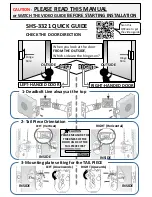
NetworkOnCard Mode of Operation
23
3 NetworkOnCard Mode of Operation
The NetworkOnCard components are permanently configured ex works for the
NetworkOnCard
mode of
operation.
3.1 What Does NetworkOnCard Mean?
The term NetworkOnCard comes from the sector standalone terminals / electronic locks (such as
PegaSys, IF 131). For persons who carry out their bookings at these terminals/electronic locks, the
booking permissions are loaded to the credential and evaluated by the mentioned devices during the
booking procedure. Instead of sending the permissions from the host system "per network" to the devices
as with online terminals, the persons carry their permissions on their credential.
Benefit of NetworkOnCard
As the devices using NetworkOnCard logic do
not need to know person-related access authorizations
,
the administrative effort for the access control systems for these devices is very low. A NetworkOnCard
reader which has been configured for the access control system only "knows" its NetworkOnCard
number, its NetworkOnCard area number (as far as area numbers are used) as well as the
NetworkOnCard groups (which are summaries of NetworkOnCard readers) which it belongs to. When you
issue new credentials, the person-related authorizations appear on the credential. The access
authorizations include information about the individual doors and NetworkOnCard groups for which the
credential has a booking authorization. During normal operation, changes to the cards at the
NetworkOnCard readers are seldom necessary.
Credential programming
For credential programming, you use either special read/write devices or online terminals that can write
data directly onto the credentials. The latter method can be used, for example, to assign authorizations to
persons for a specific period of time (e.g. for only one day) upon their first booking at such a terminal. If
such a credential is lost, this means that already on the following day, bookings can no longer be
performed with this credential at NetworkOnCard readers. Furthermore, you can inform the
NetworkOnCard reader that specific credential numbers no longer have booking authorization with
immediate effect using so-called blocking lists.
3.2 Integration of NetworkOnCard into the IF-60x0 System
The NetworkOnCard readers that you manage with the IF-60x0 system must receive the necessary
information, such as timed authorizations and membership in NetworkOnCard groups, in order to check
access bookings.
The IF-60x0 system manages all the data for operation of the NetworkOnCard reader, such as
NetworkOnCard groups, NetworkOnCard time profiles, access-authorized persons and their
authorizations.
Two methods are available for transmitting these data from the IF-60x0 system to the NoC readers:
Transmission with PegaSys Mobile
If you use NetworkOnCard technology and secure individual doors with NoC readers such as
PegaSys offline terminals or electronic lock cylinders, you can parameterize the offline devices with a
Windows computer, a connected hardware unit (NFC reader) and the software
PegaSys Mobile
.
The IF-60x0 system generates data in the form of files that are transferred to a Windows computer
(laptop/netbook). With a hardware unit connected to the Windows computer (NFC reader) and the
PegaSys Mobile
program you can transfer the data to the NoC reader and at the same time read out
booking events as well as other parameters from the NoC readers. You can further evaluate this NoC
reader data after it is transferred to the IF-60x0 system.
Transmission with programming cards
With the IF-60x0 system you can write information on specific NoC cards, e.g. door initialization
cards, in order to transmit the information to the NoC readers with these cards. Here, too, there are
special cards that you can use to transfer the bookings from the NoC readers to the IF-60x0 system.















































